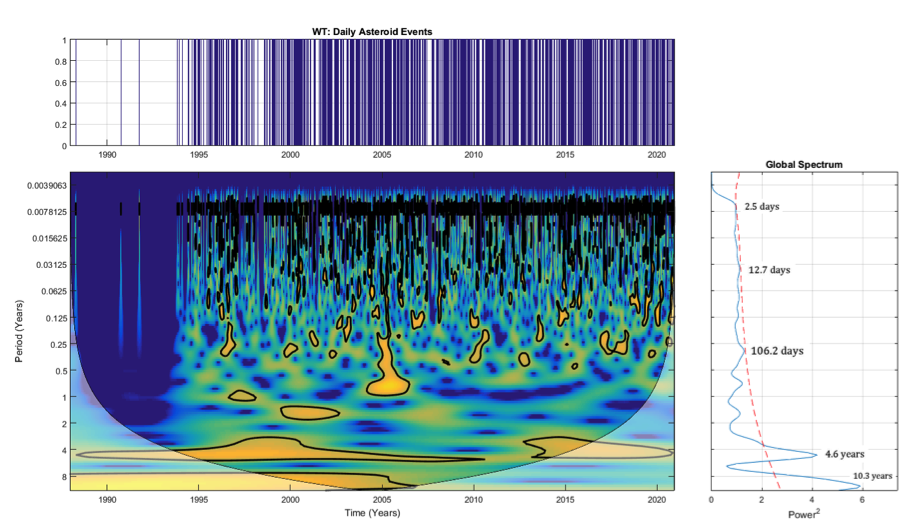Are fireballs fall on Earth modulated by our star?
- Universidad Nacional Autonoma de Mexico, Instituto de Geofisica, Sección de Riesgos Espaciales, CDMX, Mexico (dmaravil@igeofisica.unam.mx)
Abstract
In this paper we present the results obtained from the spectral analysis using the wavelet technique of a time series of brightest fireballs to look for periodicities associated with other bodies of our Solar System. The spectra show four periodicities at 106.2 days, 12.7 days, 2.5 days, 10.3 years and 4.6 years. In particular the periodicities around 12.7 and 2.5 days could be related to the Carrington rotation period.
Introduction
One of the main problems of Planetary Sciences is to understand the dynamical behavior of asteroids, meteors and meteoroids inhabiting near our planet, mainly those that fall on terrestrial surface. These bodies feel the planetary and solar gravitational influence when they travel across the interplanetary medium or mainly when they are in the terrestrial neighborhood of one of those bodies. The detection of meteoroids falling on Earth using several instruments has been important because it has permitted to obtain very useful data. The analysis of these data can help to identify the physical interactions that occur between these bodies and the rest of the bodies in the solar system. Additionally in recent decades, multiple modeling and numerical simulation works have been carried out to fully understand the origin of such interactions.
The spectral method
A time series of brightest fireballs from January, 1998 to December, 2020 was spectrally studied using the wavelet technique to look for periodicities related with Solar System bodies relationships. The data were taken from the Near Earth Object Program (https://cneos.jpl.nasa.gov/fireballs). Because of this time series has gaps, the wavelet transform was used to do the spectral analysis. The method was applied using the Morlet function (eq. 1) [1] to analyze the power spectral density (PSD) of brightest fireball meteors [1], [2], [3].
(1)
Where ω0 and η are both non-dimensional frequency and time parameter respectively
Results and discussion
Five periodicities were identified from the wavelet spectral analysis (figure 1). They are located at 2.5 days, 12.7 days, 106.2 days, 4.6 years and 10.3 years. The figure 1 shows the power spectral density spectra (PSD) where these periodicities can be seen on the right side of the plot. They are inside the cone of influence (COI) and were obtained with a confidence level of 85%. The uncertainties of every peak position were obtained from the peak full width at half maximum.

Figure 1: PSD of a time series of brightest fireballs from January, 1998 to December, 2020. On the right side of the plot, five peaks at 2.5, 12.7 and 106.2 days and at 4.6 and 10.3 years are shown.
In particular the periodicity around 12.7 days could be the first harmonic of the Carrington rotation period (27 days), [4] indicating that the solar gravitational force could be modulating the meteoroids entrance on the Terrestrial atmosphere. Carrington rotation has been detected in several time series as is the case of solar spots, storm sudden commencements, cosmic rays, among others. The periodicity around 2.5 days, it could be a small harmonic of the solar rotation period.
The mechanism behind the relationship between the variable solar radiation (due to its rotation and the solar cycle) and the fall of small asteroids to Earth´s atmosphere could be associated to the Yarkovsky and /or YORP effects. Several works have shown that the solar radiation is able to modify asteroidal orbits and rotational periods [5, 6], and it is possible that the periodicity in the variability of this radiation be the cause of periodicities in the falling of asteroidal material observed in this work. Respect to the periodicities around 4.6 and 10.3 years, they could be related to the magnetic solar cycle. The 4.6 years periodicity could be related to Jupiter too. According to NASA (https://solarsystem.nasa.gov/planets/jupiter/overvie w/), the Jupiter orbital period is 4333 Earth days, so the ratio between this period and 1679 Earth days (̴ 4.6 year period) is almost 13/5.
Summary and Conclusions
1. The Sun could be a gravitational trigger of meteoroids from their neighborhood to Earth.
2. The periodicity around 12.7 days is possible associated with the Carrington rotation as well as the 2.5 days periodicity.
References
[1] Torrence, Ch., Compo, G. P.: A practical guide to wavelet analysis, Bulletin of American Meteorogical Society, vol. 79, No. 1, pp. 61-78, 1998. https://doi.org/10.1175/1520-0477(1998)079<0061:APGTWA>2.0.CO;2
[2] Soon, W., Dutta, K., Legates, D. R., Velasco, V., Zhang, W.: Variation in surface air temperature of China during the 20th century, J. Atmos. Sol-Terr. Phy. 73, pp. 2331-2344, 2011.
[3] Velasco Herrera, V. M., Soon, W., Velasco Herrera, G., Traversi, R., Horiuchi, K.: Generalization of the cross-wavelet function, New Astronomy, 56, pp. 86-93, 2017.
[4] Nayar, S. R. P.: Periodicites in solar activity and their signature in the terrestrial environment, ILWS Workshop 2006, Goa, India, February 19-24, pp. 1-9, 2006.
[5] Farnocchia, D., Chesley, S. R., Takahashi, Y., Rozitis, B., Vokrouhlický, D., Rush, B. P., Mastrodemos, N., Kennedy, B.M., Park, R. S., Bellerose, J., Lubey, D. P., Velez, D., Davis, A.B., Emery, J. P., Leonard, J. M., Geeraert, J., Antreasian, P.G., Lauretta, S.: Ephemeris and Hazard Assessment for Near-Earth Asteroid (101955) Bennu Based on OSIRIS-REx Data, Icarus, 369, https://doi.org/10.1016/j.icarus.2021.114594, 2021.
[6] Zegmott, T. J., Lowry, S. C., Rozek, A., Rozitis, B., Nolan, M. C., Howell, E.S., Green, S. F., Snodgrass, C., Fitzsimmons, A., Weissman, P. R.: Detection of the YORP Effect on the Contact Binary (68346) 2001 KZ66 from Combined Radar and Optical Observations, Monthly Notices of the Royal Astronomical Society. 507, pp. 4914-4932, https://doi.org/10.1093/mnras/stab2476, 2021.
How to cite: Maravilla, D., Pazos, M., and Cordero, G.: Are fireballs fall on Earth modulated by our star?, Europlanet Science Congress 2022, Granada, Spain, 18–23 Sep 2022, EPSC2022-26, https://doi.org/10.5194/epsc2022-26, 2022.

